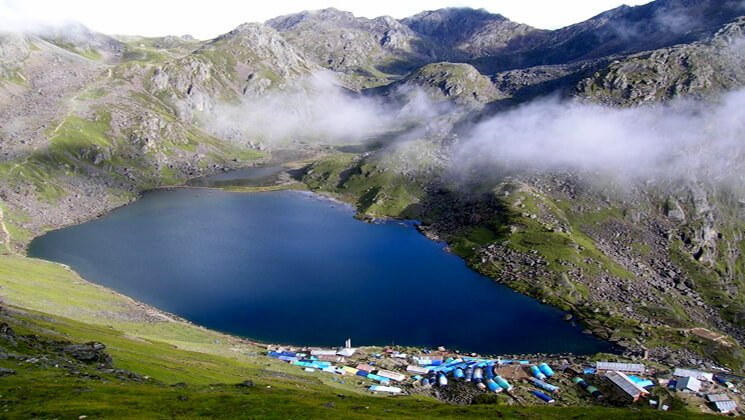Langtang Weather and Temperature
Every season has its own distinct appeal when it comes to hiking in the Langtang Valley Trek, and knowing what to expect from each one can make or break your trekking trip. The Langtang region’s breathtaking natural splendor never fails to astound visitors, regardless of when they arrive. Every season creates a unique image, from the vivid hues of spring to the serene snowscapes of winter.
Nepal has four distinct seasons: fall (September to November), winter (December to February), summer (June to August), and spring (March to May). varying temperatures, vegetation, and fauna, as well as varying weather patterns, are presented by each season. In the Langtang region, spring and autumn offer the finest trekking weather, while summer/monsoon and winter weather present greater challenges.
The benefits and drawbacks of trekking in the Langtang region throughout each season are discussed in the paragraphs that follow.
The Significance of Weather Conditions in Langtang
It is impossible to exaggerate the importance of weather when walking in the Langtang region. The trekking experience is greatly influenced by the weather, which also directly affects comfort, safety, and the enjoyment of the trip as a whole.
In the mountains, the weather might mean the difference between life and death. Weather-related abrupt shifts, like storms or a lot of snow, might put hikers in danger. To ensure your safety, it is essential to know the weather prediction and to be ready for inclement weather.
The condition of the hiking routes is affected by the weather. Excessive precipitation can cause landslides and muddy, slick pathways. Paths may become covered in snow, making passage difficult. It will be easier for you to prepare and select the appropriate gear if you are aware of the present and predicted weather.
One of Langtang’s primary draws is its breathtaking natural beauty. The visual experience might be aided or hindered by the weather. Beautiful sweeping vistas of the snow-capped peaks, verdant valleys, and colorful landscapes are made possible by clear skies and pleasant weather. Rainy or cloudy weather can make it difficult to see and hide these amazing views.
Langtang has diverse vegetation and wildlife depending on the season. Colorful wildflowers bloom in the spring and summer, and hikers can see a variety of bird species. The region’s abundant greenery is revitalized by the monsoon season. It is helpful to plan your excursion to see these natural beauties if you are aware of the weather.
Trekking To Langtang Valley ought to be a comfortable and joyful activity. Unpredictable or severe weather might cause discomfort and make the hike less enjoyable overall. Knowing the weather ahead of time makes it easier to bring the right clothes and equipment for a more enjoyable trip.
Weather can affect the chance of altitude sickness, particularly temperature and air pressure. Trekkers can lessen their chances of being sick from altitude-related problems and improve their acclimatization by being aware of the weather.
The Langtang Region Geographical Location and Famous Trekking Routes
Situated in the northern section of Nepal, close to the Tibetan border, is the Langtang region—a thrilling trekking destination. This area is a section of the Langtang Himal, a subrange of the Nepalese Himalayas, and is located inside the Langtang National Park. From roughly 1,500 meters (4,900 feet) near Syabrubesi to over 7,200 meters (23,600 feet) at the peak of Langtang Lirung, the Langtang region spans a broad range of altitudes.
Significant temperature and climatic variations exist between the higher elevations and the lower valleys as a result of this altitude variance. Temperatures typically drop and the weather turns more alpine as one ascends. The region’s diverse geography gives rise to microclimates. Slopes, ridges, and valleys can experience varying weather conditions simultaneously.
When trekking uphill or downhill, hikers should be ready for unforeseen weather conditions and temperature swings. The weather is typically more consistent and dry in the spring and fall before the monsoon. Trekking is best during these seasons because of the clear skies and comfortable weather.
Seasonal Variation in Weather in Langtang Region
Spring (March to May)
The nicest weather occurs in the Langtang Valley Trekking in the spring, when the scenery is revitalized after the winter’s chill. Because of the consistent weather and moderate temperatures, this is one of the best seasons for trekking in the Langtang region. The Langtang region’s springtime temperature and climate characteristics are listed below:
Daytime temperatures: In the spring, lower altitudes in Langtang usually see daytime temperatures between 10°C and 20°C (50°F and 68°F). Trekking in this range is comfortable and you may enjoy the terrain without being too hot or chilly.
Temperatures at night: Particularly at higher altitudes, nights can be colder, frequently plunging to freezing or slightly below.
Dry and pleasant: The dry weather of spring is well-known. As the monsoon season has not yet begun, you should anticipate comparatively little precipitation.
Table weather: The spring brings predictable weather with less likelihood of abrupt shifts. Clear skies are frequent and provide great visibility for views of the surrounding landscapes and mountains.
Rhododendron blooms: The vivid display of rhododendron flowers is one of Langtang’s most remarkable springtime sights. A gorgeous sight is created by the different rhododendron species that adorn the slopes in shades of red, pink, and white.
Wildflowers: In addition to rhododendrons, a wide range of wildflowers bloom across the area, enlivening the trails with colorful bursts and enhancing their visual appeal with each step.
Birdwatching: The spring is a great time to go birdwatching because the Langtang National Park is home to a wide variety of bird species, including Himalayan species.
Peak season and congested trails: Because of the region’s beautiful weather and striking scenery, this is the busiest time of year for trekking in the Langtang area. Due to the high volume of hikers during this time of year, popular hiking routes and teahouses may become congested.
Increased costs: Similar to spring, fall is a season of great demand, meaning that springtime rates for lodging and food may be a little higher.
Summer (June to August)
In the Langtang region, the summer or monsoon season normally lasts from June to August. The weather during this season is different from other trekking seasons. An in-depth examination of the Langtang region’s summer/monsoon climate can be found below:
Daytime temperatures: In the Langtang region, summertime highs range from 15°C to 25°C (59°F to 77°F) at lower elevations. These are generally mild daytime temperatures.
Temperatures at night: At lower altitudes, nighttime temperatures typically range from 10°C to 15°C (50°F to 59°F), although they can still be chilly. Climates may be colder at higher elevations.
Monsoon rains: The arrival of the monsoon rains is Langtang’s most notable summertime feature. There is a lot of rain in the area, particularly in July and August. Heavy rains can cause landslides and swollen waterways near hiking trails.
Humidity: The monsoon brings with it a rise in humidity. The air might feel humid and dense, which makes trekking uncomfortable.
Trails that are muddy and slick: The monsoon rains soak the terrain, creating muddy and slick trekking routes. Handling these circumstances can be difficult and even dangerous.
River crossings: During the monsoon, rivers that were manageable during the dry season may swell, so hikers should proceed with caution and possibly look for other routes.
Leeches and insects: Along the trekking routes, the humid monsoon season brings forth leeches and insects. Hikers must take safety measures to avoid being bitten.
Travel delays: Severe rains can cause road closures and other transportation-related issues. Trekkers who are traveling to and from the Langtang region may encounter delays.
Rich vegetation: The region’s rich vegetation is revitalized by the monsoon season. The woodlands are brimming with life, and the scenery turns breathtakingly green.
Wildlife: Trekkers may have the opportunity to see a variety of species, including a wide variety of birds, as the Langtang region’s wildlife becomes more active throughout the summer.
Rain Gear: During the summer, it is imperative to have the necessary rain gear, such as strong, waterproof footwear, covers for backpacks, and waterproof apparel.
Autumn (September to November)
In Langtang, autumn is one of the best seasons for hiking. Trekkers can enjoy a pleasant combination of temperate temperatures, reliable weather, and breathtaking natural scenery from September to November. The Langtang region’s autumnal temperature and climate are examined in depth below:
Autumn delivers nice, comfortable daytime temperatures, which at lower elevations usually range from 10°C to 20°C (50°F to 68°F). Trekking in this range is pleasant and you may enjoy the trails without getting too hot.
Temperatures at night: Although daytime highs are often pleasant, evenings can be chilly, frequently falling to freezing or even lower, particularly in higher elevations.
Dry and stable: The weather in the fall is dry and steady. Since this season comes after the monsoon, hikers could anticipate less rain and fewer unfavorable weather occurrences.
Clear skies: During the fall, clear, blue skies are typical, offering great visibility for views of the surrounding landscapes and mountains.
Vibrant displays of fall foliage: One of the best things about trekking in the fall is the colorful scenery. Rich vegetation and vibrant wildflowers decorate the hillsides, resulting in a charming and welcoming setting.
Encounters with Wildlife: Autumn is a great season for birdwatchers and wildlife enthusiasts. It’s possible that you’ll see different kinds of birds and other animals, such langur monkeys and red pandas.
In Langtang, autumn is one of the best seasons for hiking. Trekkers can enjoy a pleasant combination of temperate temperatures, reliable weather, and breathtaking natural scenery from September to November. The Langtang region’s autumnal temperature and climate are examined in depth below:
Autumn delivers nice, comfortable daytime temperatures, which at lower elevations usually range from 10°C to 20°C (50°F to 68°F). Trekking in this range is pleasant and you may enjoy the trails without getting too hot.
Temperatures at night: Although daytime highs are often pleasant, evenings can be chilly, frequently falling to freezing or even lower, particularly in higher elevations.
Winter (December to February)
Because of its distinct climate and frigid temperatures, the Langtang region’s winter season—which normally lasts from December to February—offers a trekking experience that is unlike any other. The Langtang region’s wintertime temperature and climate are examined in depth below:
Daytime temperatures: Cold daytime temperatures, particularly at higher elevations, are a hallmark of winter in Langtang. Daytime temperatures at lower elevations can vary from 5°C to 10°C (41°F to 50°F). But the temperature drops sharply as you go higher up, frequently falling below freezing.
Temperatures at night: It gets much colder at night, often well below freezing. Temperatures might drop to as low as -10°C to -20°C (14°F to -4°F) or even lower, depending on the particular.
Clear, dry skies: Winters are often dry with little to no precipitation. Snowfall is possible at higher altitudes. There are often clear, blue sky with good daytime visibility.
Limited daylight: There are less daylight hours for trekking during the shorter winter days. To make sure they have enough time to get at their destination before dusk, hikers should carefully plan their daily itinerary.
Trails covered in snow: During the winter, trekking trails—especially those at higher elevations—are probably going to be blanketed in snow and ice. Hikers may find it more difficult as a result, and crampons or other appropriate equipment may be needed.
Extreme cold: The biggest obstacle to walking in Langtang in the winter is the bitter cold. Trekkers need to be equipped with the right cold-weather gear, such as caps, gloves, insulated clothes, and top-notch thermal layers.
Limited accommodations: Some teahouses and lodges in isolated places may temporarily close because to the decline in trekkers throughout the winter. Trekkers can guarantee a comfortable trip by carefully planning their routes and packing extra supplies.
Peace and quiet: Winter is the least popular time of year to hike in Langtang. This is the ideal time to take in the serene beauty of the area without the crowds if you’re looking for seclusion and quiet trails.
Weather-Related Challenges and Safety Tips
While trekking in the Langtang region is an amazing experience, there are certain hurdles to be faced due to the unpredictable Himalayan weather. Be mindful of potential weather-related concerns and adhere to safety standards to ensure a pleasant and safe walk. Some of the most common weather-related issues and safety advice for trekking in the Langtang area are listed below:
Temperature variations
Challenge: Significant temperature differences occur in the Langtang region, particularly with altitude changes. Higher altitudes can be very chilly, especially in the winter, while lower elevations might have milder weather.
Wear layers of clothing to adjust to temperature changes as a safety precaution. Even if you are walking during the busiest months, pack cold-weather gear such as thermal layers, insulated clothes, gloves, and hats.
Altitude sickness
Challenge: Altitude sickness is brought on by variations in altitude and can be a severe issue. Breathlessness, nausea, and headaches are some of the symptoms.
Here’s a safety tip: Make sure you prioritize appropriate acclimatization by gradually increasing altitude and giving your body enough time to become used to it. Keep yourself well-hydrated, abstain from alcohol and tobacco, and be mindful of altitude sickness symptoms.
Limited visibility
Difficulty: Mist, fog, and clouds can reduce visibility, making it harder to navigate and obstructing vistas of mountains.
Safety advice: Bring a reliable map, a compass, or a GPS unit, and think about hiring a knowledgeable local guide who is experienced with the area. When trekking in low visibility, exercise caution.
Monsoon rains
Challenge: The area experiences high rainfall throughout the summer monsoon season, which causes muddy and slippery paths, overflowing rivers, and landslides.
Safety advice: Steer clear of trekking in the midst of the monsoon. Bring rain coverings for your backpack and waterproof gear if you want to trek during the rains. Take heed of the trail conditions. Regularly check the weather forecasts.
How to Stay Informed of Weather Conditions during Trekking in Langtang?
You must be abreast of the weather while walking in the Langtang region. The weather in the Himalayas is incredibly erratic, so you need to be mindful of your surroundings and any changes in the weather. You can ask the folks in the villages and owners of teahouses about the weather while you’re trekking. They can offer short-term forecasts and frequently have insightful knowledge of the local climate.
Since you will be trekking in the Langtang area with a knowledgeable guide, he will ensure that the group travels securely by drawing on his experience and local knowledge. Make sure you are well informed about the usual weather during the trekking season before you go on your journey. This will assist you in getting ready appropriately and making wise choices as you go.
Anywhere you travel, including the Langtang region, being aware of the weather is essential to a pleasant and uneventful trip. We hope that this blog will be useful to you and provide the majority of the answers to your inquiries about the weather in the Langtang region. Please do not hesitate to contact one of our travel consultants with any more questions.
We can’t recommend highly enough that you think about hiking with a local firm like ours. Local trekking firms are quite familiar with the area, its people, and its climate. We at Sherpa Expedition and Trekking offer professional direction, guaranteeing your security and comfort as we assist you in finding Langtang’s hidden treasures.
Additionally, you promote sustainable tourism practices and the local economy by selecting a business like ours. Trekking in Langtang is an amazing experience that will leave you with lifelong memories, regardless of expertise level. Whether you’re an experienced trekker or this is your first trip to the Himalayas.






